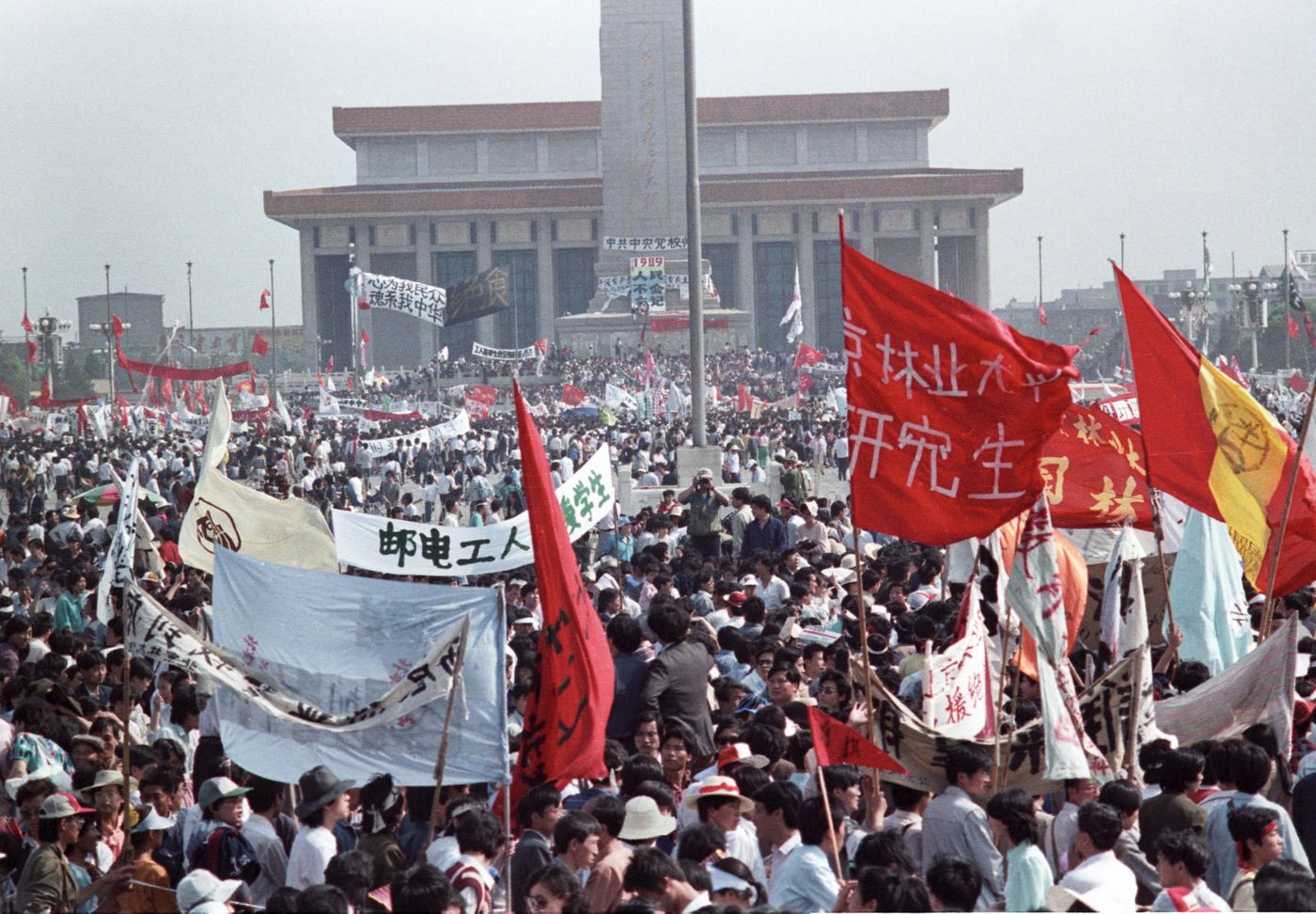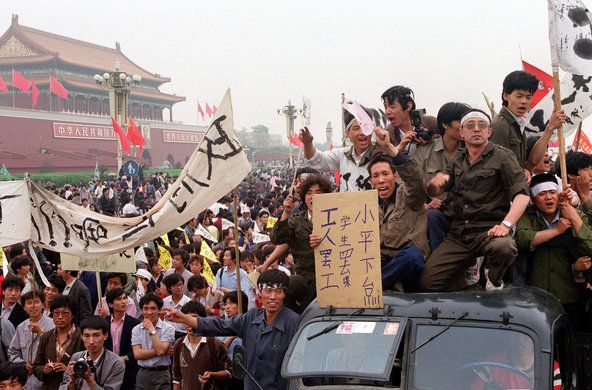其實,這篇只是讀書筆記。
之前申請社會所博士班時,為了寫研究計畫再讀趙鼎新的作品,適逢六四,就用他這本也算在西方學界廣為流傳的The Power of Tiananmen: State-Society Relations and the 1989 Beijing Student Movement(天安門的力量:國家-社會的關係和1989年學生運動)來回顧那年的學運是如何開始的。
這本書在某方面來說,可稱之「客觀」,趙鼎新認為從一開始運動者和政府的基本立場就無可調和,換言之,走向暴力終結也是無可避免的結果。由於趙先生的文筆甚好,若讀者在他完整的立論下被說服也不太意外。
然讀書很重要的一點是作者的立場——不是指他個人的政治傾向,而是他現在身處哪個位置,趙鼎新目前在浙江大學任教,有些人暱稱他為「趙國師」。對於這類已經在西方學界取得重要成就(他的書作為相關課程閱讀材料的比例之高、以及他本身在芝加哥大學社會所取得終身職),最終仍選擇回到中國且能謀得職位的中國學者,我總是未讀他們的作品就先抱著三分懷疑。
既然趙鼎新往後的際遇如此,就表示他對六四的論述是中國官方認可的(要知道這本書是有簡體中譯本的),既是官方認可,客觀性自然打折。
不過,若單從學術研究的角度來讀,這本書在描述學運起源時仍然有其有趣之處,例如,以我所讀到的趙鼎新,算是芝加哥學派生態理論( Ecological school)的佼佼者(這也可能是我的誤讀,畢竟我不是社會系出身),而他連結了中國初創時代,中央為了控制知識份子把幾十間北京的高等學校擠在同一個範圍,後來這個狹小密集的校區加速了八九學運時各校學生的串連,像是這觀點我就認為是意想不到的原創。
趙鼎新是以社會學的角度寫這本書的,不過既然自己要去政治學博士班,以下就用之前政治學課堂上討論政權面對大規模群眾運動挑戰時如何因應的套路來設定幾個問題,用以摘錄書中的要點(Kindle版本,只有location沒有頁碼)。
What factors contributed to the student protests?
According to Zhao, there were at least three factors that contributed to the student protests. First, during the late 1980s, students and Beijing residents started to evaluate the state by its economic and moral performance. However, the top state elites still maintained their communist ideology. This contrast of understanding of state legitimation led to the conflict between the regime and general public (loc.271). Another key factor is that there were highly concentrated campuses being set up in the same district. This made for a perfect environment in which students from 67 universities could build close-knit networks and act collectively. This environment also facilitated interuniversity competition for activism. Finally, the effectiveness of state control on students was declining at the time. Given the above factors, when the Chinese economy was in a crisis and living standards of intellectuals worsened and students were having difficulty finding ideal jobs after school, crisis discourse became easy to spread on campus and mobilize the aggrieved population (loc.308-316).
Who were the primary organizers of the protests? How well organized were they?
On April 17 1989, 600 young teachers and students from the University of Political Science and Law organized the first protests. Then students in Beijing University followed. This demonstration was initially without an actual plan, and the demands of the protests emerged on the half way through the demonstration. Two days later, the student movement organization emerged. Zhao points out that even though there were several organizations and self-appointed student ladders mobilizing the protests, no one could control the direction of the movement. On the other hand, although the organized job structure was very random and messy, student leaders effectively used rumors to mobilized more students and successfully brought the movement to the next, more militant stage (loc.1806).
How would you apply Lichbach's argument about repression and protest to the Tiananmen case? How did the regime's approach to repression evolve over time? Was repression initially consistent?
Lichbach provides a Ration Actor model to explain how opposition groups (the tactics of contenders) and regimes (repressive tactics of government) interact. He argues that the regime is the key factor that influences opposition activity because it alters the costs of an opponent’s tactics (289). He also argues that whether an increase in the regime's repression increases or decreases the opposition group's total dissident activities depends upon the government's accommodative policy to the group (293). In the Tiananmen case, the regimes’ indefinite concession and threat policies caused a different reaction from students. The students’ reaction was also changing rapidly and could remain consistent. After Hu Yaobang’s funeral, the regime was initially determined to take firm measures to calm the student turmoil as soon as possible.
However, the official newspaper People’s Daily’s editorial announced this threat of repression, triggering a large-scale demonstration. New protests caused the regime to shrink back. Its approach toward repression was also moderated by Zhao Ziyang. Top state elites stepped back and waited to see if Zhao’s concession could bring about an end to the movement (loc.2763). According to Lichbach’s RA model, opponents hence altered their tactics— regime concessions encouraged students to drive toward the next radical move as they underestimated the costs (loc.2904). After the protests upgraded to hunger strikes, the regime went back to their original plan of repression.
What factors contributed to the regime's ultimate decision to crack down?
There is no doubt that the hunger strike was the turning point of the student protests, and the key factor which ultimately led regime’s military repression. Hunger strikes fundamentally challenged the regime’s ideology and morality. Moreover, it turned the movement into a zero-sum game (loc. 2822). At the time, Zhao Ziyang was the only top leader who still held the illusion that concessions could convince the students to stop hunger striking and withdraw from Tiananmen Square. Although until May 15, the Chinese government still tried to negotiate with the students, even the student leaders who initiated the hunger strike could not stop it. Also, among the expansion of the scale of the movement, those student leaders already lost control of the movement and the movement radicalized itself (loc.2341-2381)— which resulted in a deadlock between students and the regime.
The student occupation of Tiananmen Square caused many activities surrounding the Gorbachev trip to be canceled or rescheduled. That helped convince most of the top state elites to decide that the regime should take action. Those top state elites, include military leaders, who experienced the revolution before 1949 believed that military repression was the only way to solve this crisis (loc.2905).


以上,或可給大家對六四如何在1989年春天成了六四一個簡單的回顧。
不過,在30多年後的今天,釐清六四的起因和結果似乎不再是最重要的任務了。更重要的是此時此刻的我們如何看待、回顧、和紀念這個事件——尤其今年開始,香港維園紀念活動已成為絕對的政治禁忌。
我們應該看重六四這個事件本身?還是看重「連在香港,所有的六四記憶都會消亡」這個事實多一點?我們需要緊抓著歷史不放,還是關心現世,關心此時此刻被摀住嘴巴、被拔除記憶的人。
又或者,人們對此再無能為力。
今年四月份時西蒙非斯大學的歷史系教授Jeremy Brown出版了最新的六四研究June Fourth:The Tiananmen Protests and Beijing Massacre of 1989,他在一場新書座談會上提到,最近中國網軍總以George Floyd之死以及過去的美國奴役黑人史、和最近在BC省發現215具原住民小朋友屍體來質疑Brown作為一個美裔和加裔學者,說他沒有資格談論中共在天安門廣場的「屠殺」。
「然而所有的關於屠殺的歷史都應該被研究,」Brown如是說,「如果一個屠殺事件因為政府各種審查而被停止談論,而作為一個歷史學者,如果你無法朝歷史事實更進一步,那不只是污辱了被害者和倖存者,而是根本打整個歷史學界一巴掌:竟然有一個歷史事件無法被研究。」
這本書我還沒讀完,或許會再擇期寫心得。
不過Brown出版這本書,提醒了我:在六四事件裡還有太多的人事沒有/來不及被談論就被掩蓋了,在中國,許多因為六四入獄的外省民工、農民連名字都沒有,可是身處中國之外,我們仍然是可以書寫的人,還有機會說出他們的名字,找出他們對如何好好作為一個人、一國之民的想望,並寫下他們的故事。
六四作為一代中文使用者的集體記憶,不該隨著香港維園的禁令而消亡,要是如此,那中共在1989年遏止的,就不只是中國人的自由和人權(也許不是每個中國人都在意這個),他們終將抹去在身處自由世界的我們賴以為繼的價值。
而這個世界離向中國價值(無論那是什麼)屈服,曾經也就只有一步之遙。
from Matters | 熱議 https://matters.news/@Rollopinion/%E5%85%AD%E5%9B%9B%E8%AE%80%E6%9B%B8%E7%AD%86%E8%A8%98-bafyreibe2conlne5kdpykrsv53cw7qhpq5xl5fbjw6puweome4oeuglbsq